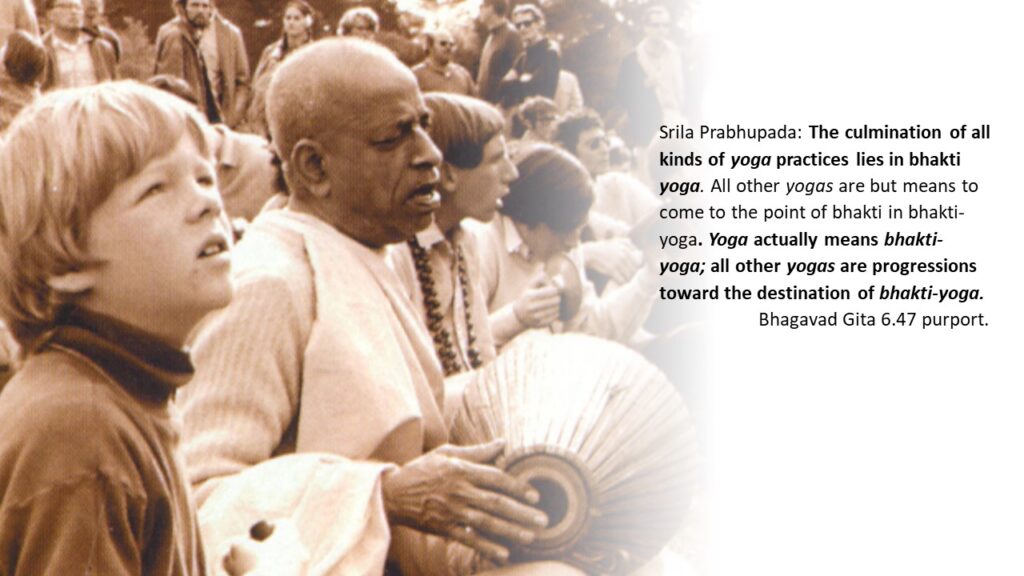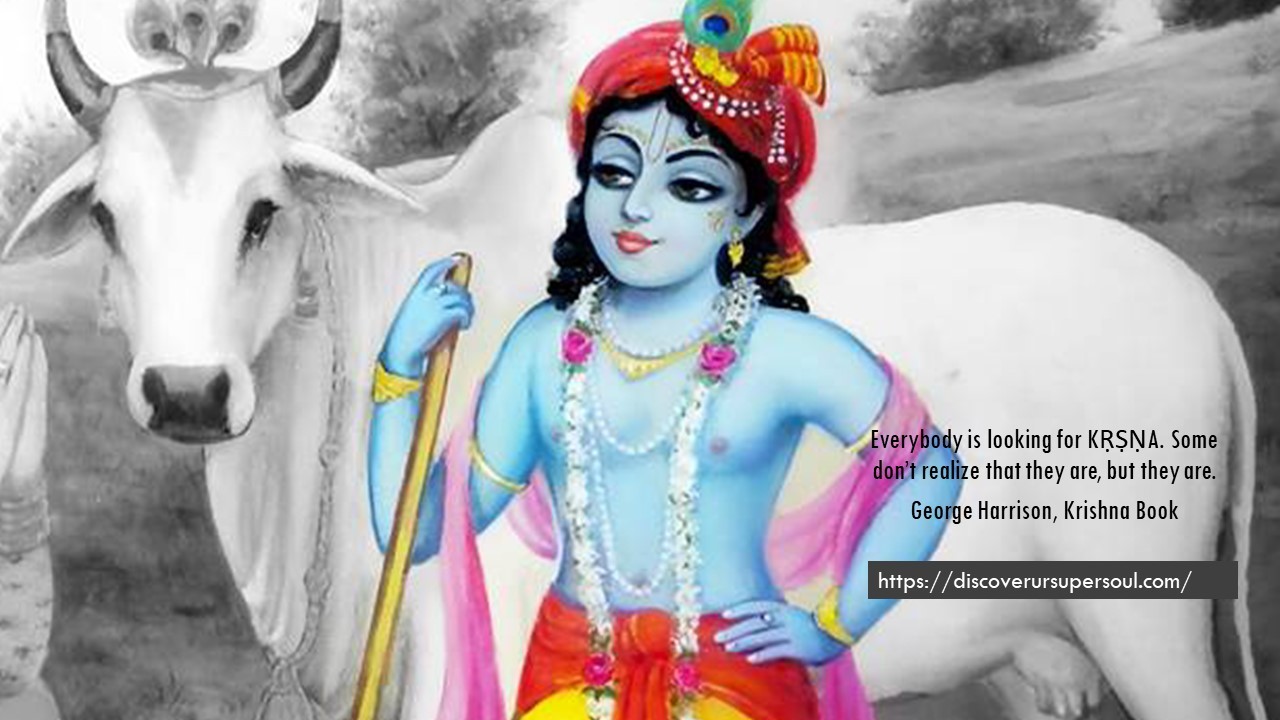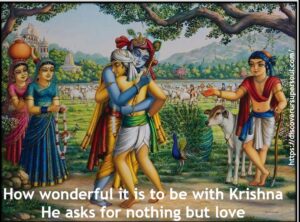
There are unlimited benefits of Bhakti Yoga. There are many yoga systems explained in the scriptures but amongst all these yoga practices Bhakti Yoga is considered topmost. Especially in this age of Kaliyuga it is quite difficult to practice other yoga systems like Karma Yoga, Jnana Yoga and Astanga Yoga but it is easy to practice Bhakti Yoga.
Let us see the challenges of other yoga systems and benefits of Bhakti Yoga.
Challenges in Karma Yoga
There are two types of Karma Yoga – sakama karma yoga and niskama karma yoga.
In karma yoga one may have understanding about the Supreme Lord but he may not know that the Supreme Lord is Lord Krishna.
A sakam karma yogi will have attachment to the fruits of his activities and he may worship the Lord for material results. In fact, sometimes a sakam Karma yogi may also approach demigods for results.
A sakam karma yogi gradually comes to the platform of niskama karma yoga. Niskama karma yoga means no attachment for fruitive results. Coming from the stage of sakam karma yoga to niskama karma yoga may take lots of times, it could be many lifetimes also. In Niskama Karma Yoga, the practitioners have to do his duties perfectly as per the scriptures following varnashrama dharma but he should not be attached to the results.
It means while doing his work he should be completely detached. It is easy to say but quite difficult to practice.
Challenges in Jnana Yoga
In Jnana Yoga one acquires knowledge by studying 24 material elements. Jnana Yoga is also called sankhya yoga. By studying and analysing the 24 material elements, a Jnana Yogi tries to understand that they are souls and not material body comprising of gross and subtle elements. They also try to understand this material world and come to the conclusion that everything in this material world is temporary. With this understanding they develop renunciation.
For Jnana yogi, renunciation means negation. It means that they have to suppress all their desires and emotions and remain inactive. But as souls we cannot remain inactive. Souls need constant engagement. So, the process of Jnana yoga is dry and not pleasing to the heart.
Challenges in Astanga Yoga
In astanga yoga the practitioner has to go through different stages of eightfold yoga system. The eightfold yoga system includes – yama, niyama, āsana, prāṇāyāma, pratyāhāra, dhāraṇā, dhyāna and samādhi. The process of elevation is gradual here. In Bhagavad Gita 6.11 – 6.14, Lord Krishna explains how astanga yoga should be practiced.
“To practice yoga, one should go to a secluded place and should lay kuśa grass on the ground and then cover it with a deerskin and a soft cloth. The seat should be neither too high nor too low and should be situated in a sacred place. The yogī should then sit on it very firmly and practice yoga to purify the heart by controlling his mind, senses and activities and fixing the mind on one point. One should hold one’s body, neck and head erect in a straight line and stare steadily at the tip of the nose.” Thus, with an unagitated, subdued mind, devoid of fear, completely free from sex life, one should meditate upon Me within the heart and make Me the ultimate goal of life.” Bhagavad Gita 6.11 – 6.14
In this age of kali yuga people are short lived and their mind is always agitated, so it is difficult to practice astanga yoga. These days there are almost no forest, so finding a secluded place is also very challenging.
Moreover, to practice astanga yoga one has to leave his home which may not be possible for all. For women to leave home and live in a secluded place to practice astanga yoga will be very difficult.
7 benefits of Bhakti Yoga in this age of Kaliyuga
Now let us see why Bhakti Yoga is topmost. And what are the benefits of Bhakti Yoga as compared to other yoga systems.
1. Anyone can do Bhakti Yoga
There is no prerequisite to perform Bhakti Yoga. Men, women, young, old, Hindus, non-Hindus, Indians, non-Indians everyone is eligible to perform Bhakti Yoga. In Bhakti Yoga the most important requirement is that one has to chant the holy names of Krishna like the Hare Krishna Mahamantra and follow four regulative principles of no meat eating, no gambling, no intoxication and no illicit sex.
2. Easy to Control mind and senses in Bhakti Yoga
In all the other three yoga process – karma yoga, jnana yoga and astanga yoga – one has to put in a lot of efforts for practicing sense and mind control. But in Bhakti Yoga the emphasis is not much on sense and mind control, but the emphasis is more on using the senses and mind in serving Krishna. Now when the senses and mind are absorbed in serving Krishna then the senses and mind automatically gets purified. And for the practitioner of Bhakti Yoga it becomes easy to control the purified senses and mind.
3. Bhakti Yoga is about relationship with Krishna
In Jnana Yoga and Astanga Yoga the process is to renounce the world, renounce the relationship. So, it is not pleasing to heart. But in Bhakti Yoga the emphasis is on developing everlasting relationship with Krishna and Krishna’s devotees, so it is pleasing to the heart.
4. One works for Krishna’s pleasure
In Niskama Karma Yoga, once does work just as a matter of duty without any desire for result. But in Bhakti Yoga one does work for the pleasure of Krishna. For example, Srila Prabhupada was always engaged in work, but he did it for the pleasure of Krishna and so Srila Prabhupada was always joyful. We see in Ramayana Hanuman worked hard for Lord Rama’s pleasure. Similarly, Arjuna fought the Mahabharat war for the pleasure of Krishna.
5. Krishna reveals knowledge in Bhakti yoga
Śravaṇaṁ (hearing) and kīrtanam (chanting) is important part of Bhakti Yoga. A Bhakti Yogi relishes the pastimes of Lord Krishna and its philosophical explanation. Hearts get purified by regularly hearing Krishna’s pastimes. And gradually the knowledge is also revealed to the Bhakti Yogi that they are souls parts and parcel of Krishna. A Bhakti Yogi gradually understands his constitutional position as the servant of Krishna and understands that this material world is temporary. He also understands about this world and how this world functions.
6. Purification is easy and much quicker in Bhakti Yoga
In Karma yoga, Jnana Yoga and Astanga Yoga purification takes lots of times, sometimes many lifetimes. But in Bhakti Yoga one gets quickly purified especially if one gets association of pure devotees. Mrugrari, the cruel hunter, got purified by the association of sage Narada. Similarly, hippies who were indulging in many sinful activities got purified by the association of Srila Prabhupada. In my personal life also I have seen that once I started practicing Bhakti Yoga then it became easy to give up many sinful habits like meat eating, attraction towards opposite sex etc.
7. In Bhakti Yoga one attains Krishna and goes back to Krishna’s abode
In Karma Yoga and Jnana Yoga one may come to the stage of Brahman realization. So a Karma Yogi and Jnana Yogi after leaving the body will merge into Brahman effulgence. In Astanga Yoga one may come to the stage of Paramātmā realization. An Astanga Yogi as per his consciousness gets the next destination after leaving the body. But it is only in Bhakti Yoga that one may have Bhagavan realization. Bhagavan realization is topmost, and it includes Brahman and Paramātmā realization. A Bhakti Yogi can only attain Krishna and return back to Krishna’s abode, Goloka Vrindavan.
Bhakti yoga is topmost
These seven benefits of Bhakti Yoga establishes that Bhakti Yoga is topmost yoga. This is also confirmed by Lord Krishna. “And of all yogīs, the one with great faith who always abides in Me, thinks of Me within himself and renders transcendental loving service to Me – he is the most intimately united with Me in yoga and is the highest of all. That is My opinion.” Bhagavad Gita 6.47
Srila Prabhupada explains, “The culmination of all kinds of yoga practices lies in bhakti yoga. All other yogas are but means to come to the point of bhakti in bhakti-yoga. Yoga actually means bhakti-yoga; all other yogas are progressions toward the destination of bhakti-yoga.” Bhagavad Gita 6.47 purport.
Knowing this a Bhakti Yogi engages every moment of his life in the service of Krishna and lives happily in this world and leaves for Krishna’s abode after leaving this world.













